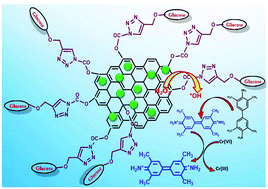Cu(0) nanoparticle-decorated functionalized reduced graphene oxide sheets as artificial peroxidase enzymes: application for colorimetric detection of Cr(vi) ions†
Abstract
Graphene oxide (GO) sheets were functionalized by a “click” chemistry approach using azide modified GO and alkynyl-terminated D(+)-glucose precursors to produce glucose terminated hydrophilic GO surfaces. This hydrophilic functionalized GO surface was utilized for the decoration of Cu(0) nanoparticles for sensitive colorimetric detection of Cr(VI) ions, which has not been explored to date. The nanocomposite exhibited excellent peroxidase mimic activity towards the colourless chromogenic substance, 3,3′,5,5′-tetramethylbenzidine (TMB), to yield a blue coloured substance 3,3′,5,5′-tetramethylbenzidinediimmine (TMBDI). In an acidic medium, Cr(VI) can decompose H2O2 to molecular O2 and H2O. Both O2 and H2O can form hydroxyl radicals (˙OH) by combining with the electron of the peroxidase substrate, resulting in enhanced TMB oxidation in the presence of Cr(VI). This colorimetric method was highly selective towards Cr(VI) ions with a limit of detection (LOD) of 67.13 nM.



 Please wait while we load your content...
Please wait while we load your content...